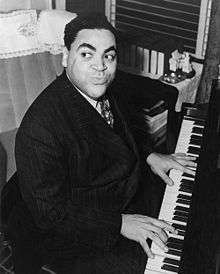Stride (music)
Harlem Stride Piano, stride piano, commonly abbreviated to stride, is a jazz piano style that was developed in the large cities of the US East Coast, mainly New York City, during the 1920s and 1930s. The left hand characteristically plays a four-beat pulse with a single bass note, octave, seventh or tenth interval on the first and third beats, and a chord on the second and fourth beats. Occasionally this pattern is reversed by placing the chord on the downbeat and bass note(s) on the upbeat. Unlike performers of the ragtime popularized by Scott Joplin and unlike much early jazz, stride players' left hands often leapt greater distances on the keyboard, and they played in a wider range of tempos and with a greater emphasis on improvisation.

Technique
Stride piano is highly rhythmic because of the "oom-pah" (alternating bass note / chord) action of the left hand. In the left hand, the pianist usually plays a single bass note, or a bass octave or tenth, followed by a chord, while the right hand plays syncopated melody lines with harmonic and riff embellishments and fill patterns. There are many differences between stride and one of its roots, ragtime. Unlike ragtime pianists, stride players were not concerned with ragtime form and played pop songs of the day in the stride style. Also, while the original ragtime music was composed, many stride pianists possessed impressive improvisational skills, and were not therefore reliant upon a printed score. Some of the finest players, in fact, did not read music at all. Lastly, authentic stride makes use of tension/release, dynamics, and can be played at all tempos, slow or fast depending upon the underlying composition the pianist is performing. Some younger pianists have transcribed display pieces note for note from early recordings. However this practice is not really jazz piano.[1]
James P. Johnson (1891–1955), known as the "Father of Stride," created this style of jazz piano along with fellow pianists Willie "The Lion" Smith (1893-1973), Thomas "Fats" Waller (1904–1943) and Luckey Roberts (1893-1968). One of Johnson's greatest contributions was to recast the "straight" feeling of ragtime with a more modern, swinging beat, sophisticated harmonics and dynamics.[2] He discovered and employed the tenth or "broken tenth" interval among other devices. The pianist could not only substitute tenths for single bass notes, but could also play broken (staggered) tenths up and down the keyboard[3]
Stride pianist Art Tatum (1909–1956) (a fan of early jazz pianist Lee Sims, who was himself a fan of the European "Impressionist" pianists such as Debussy and Satie, and hosted a radio program Tatum enjoyed) introduced more complex harmonies into his playing, and, like Fats Waller, would start songs with legato explorations of chordal intricacies, before launching into "Swing" (a touch also, apparently, inspired by Sims). Tatum was awarded a posthumous Grammy for his contributions to jazz, in 1974.[1]
True Stride pianists practiced a full jazz piano style that utilized highly creative, often flamboyant devices such as arpeggios, black note slide-offs, varying rhythmic accents, and tension/release. They often engaged in marathon cutting contests to show off their skills.[4]
Notable practitioners
Other notable stride, and stride-inspired, jazz pianists of the 20th century included Thelonious Monk, Johnny Guarnieri, Don Ewell, Donald Lambert, Cliff Jackson, Dick Wellstood, Pat Flowers, Mary Lou Williams, Joe Turner, Claude Hopkins, Ralph Sutton, Hank Duncan, Dick Hyman, John W. Bubbles, Jaki Byard and George Winston.
Other prominent stride jazz pianists are Butch Thompson, Mike Lipskin, Bernd Lhotsky,[5] Louis Mazetier, and Stephanie Trick, who perform internationally.
Notable works
- By James Price Johnson
- "Carolina Shout" (1918/1921), "Mule Walk," "Caprice Rag"
- By Thomas "Fats" Waller
- "Handful of Keys" (1929), "Vipers Drag" (1934), "Alligator Crawl" (1934)
- By Willie "The Lion" Smith
- "Finger Buster" (1931), "Echoes Of Spring" (1939)
See also
References
- 1 2 "Piano Styles—Ragtime to Boogie-Woogie", McGraw-Hill Higher Education.
- ↑ Schuller, Gunther (1986). Early Jazz: Its Roots and Musical Development. New York: Oxford University Press. pp. 216 & 221. ISBN 9780195040432.
- ↑ Scivales, Riccardo (1990). Harlem Stride Piano Solos. Ekay Music. pp. 06,34:About Harlem Stride Piano,Carolina Shout. ISBN 0-943748-43-7.
- ↑ Ken Burns (director) (2001). "The Gift" (part 2 of Jazz) (Documentary). PBS.
- ↑ Ken Dryden, review of Bernd Lhotzky, Piano Portrait (CD, 2006), AllMusic
External links
- Original recordings of James P. Johnson online at the Library of Congress National Jukebox
- Stride Piano on BlueBlackJazz
- Dick Hyman Explaining Stride (YouTube)
- Dick Hyman Illustrating Ragtime to Stride Piano (YouTube)
- Thomas Fats Waller website. A tribute to the King of Stride Piano